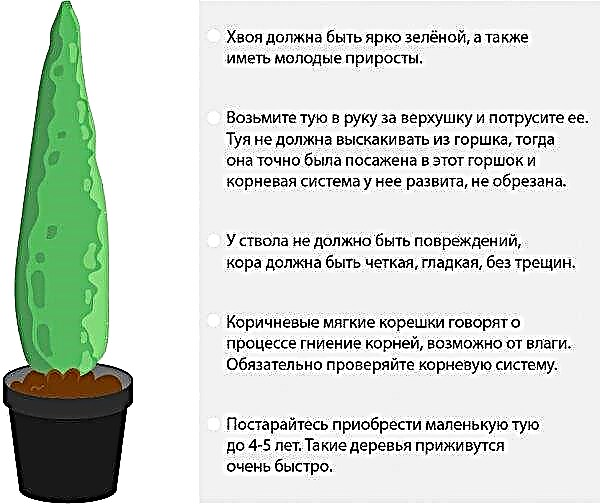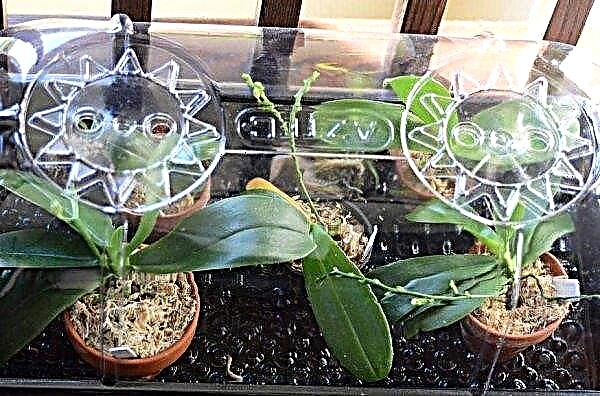One of the easiest to care for, taking up little space on the windowsill and at the same time striking with its exotic flowering - these are cacti. Among them, the leading position in popularity is occupied by ferocactus. About what types of plants are, how to care for ferocactus at home and propagate - read in our material.
Botanical description of the plant
Ferocactus is a succulent plant that can be found in the deserts of Mexico, California, South America. The stem is round or oblong, fleshy. The roots reach a length of 20 cm, white and thick. A single stem sometimes reaches 4 m in height and 80 cm in width. Its surface is ribbed, with a triangular section. On the ribs are flat areas from which bundles of needles with a gun grow. At the very top is a soft recess.
Each bundle contains about 13 needles of different lengths. Flowers in plants reach more than 25 cm in height. They can be white, yellow or pink, formed on the sides and at the top. Ferocactus are long-livers and can live up to 100 years in natural conditions. At home, they won’t be able to create their usual conditions, so they rarely cross the 10-year mark.Did you know? In the distant past, Latin American doctors sterilized cactus needles sutured the wounds of patients.
Main types
Ferocactus have more than 30 species, but not all can be grown at home. Below are the most common ones.
Wide-eyed
It is also called latispinus. It has a cylindrical stem up to 40 cm wide, green-blue in color, with high ribs. Thanks to the color of the spines, which can be pink or white, this look looks attractive even without flowers. The needles are collected in bundles in a circle, and some of them are thickened and flattened. For its interesting shape, it is called the “damn language”. At the top there are several red buds.
Ford
This species has a gray-green stem shaped like a ball. It has 20 ribs, light spines, which in the center have a hooked shape. Purple flowers.
Powerful
Got a name for its impressive size. This ferocactus reaches a height of 1 m and a diameter of 3 m. It has 8 edges and small bright yellow flowers.
Straight-throated
It has a cylinder-shaped stem up to 1 m in height and 30–35 cm in diameter. The thorns are very long - up to 25 cm, with pink tips. The flowers are yellow.
Cylindrical or asantic
The stems are cylindrical in shape, grow individually, up to 3 m high and 50 cm in diameter. The stem is divided into 30 straight ribs with tubercles. Flowers of this species are yellow or orange.
Imari
This representative has rare ribs, the height of its stem reaches 1.5 m. Prickles up to 8 in one bunch, they are white or red. Spotted flowers are red with yellow.
Porcupine
The stem looks like a ball of green-blue color and has 24 ribs covered with brown spikes. The flowers are shaped like a bell with yellow petals.
Home Care
Ferocactus are unpretentious plants, and with proper care they will also please with unusual flowering. Caring for them is not difficult.
Did you know? California Cereuses are the tallest cacti in the world. Their height can reach 20 m. Their stems can contain up to 2 tons of fresh water that can be drunk.
Location selection and lighting
Since this plant is an inhabitant of hot countries, then in the apartment he needs to highlight the lightest and warmest window sill. The south side is ideal for this. On cloudy days, ferocactus needs additional illumination.
Temperature mode
In the spring-summer period, the cactus needs warmth and fresh air. He is quite satisfied with the temperature up to + 35 ° С. The plant can be taken out to the balcony or to the street. During rest, the temperature should be cooler - +10 ... + 15 ° С. Drafts should not be allowed.
Air humidity
Dry room air succulent is quite suitable. Additionally, the plant can be sprayed on hot days in the summer, and even then only in order to bring down dust from it. In winter, the air should be dry.
How to water in winter and summer
In the warm season, ferocactus should be watered when the soil on the surface of the pot is already completely dry. For this, only settled water at room temperature is suitable. During dormancy (fall-winter), watering is minimized.
Important! In winter, ferocactus is better not to water at all than often. During the rest period, he practically does not need water.
Fertilizer application
What is good about ferocactus is its undemanding to the soil. In nature, it grows in the sand and among stones, so it does not need additional nutrition. If desired, you can fertilize the plant with special preparations for succulents, but the dosage should be halved.
Transfer
While the prickly exot is young, the first few years it is transplanted every spring. At the same time, the flowerpot is selected one size larger (2-3 cm wider and deeper). Plants older than 3 years can be transplanted every 3-4 years - they will benefit from this. The pot is chosen wide and low, with large drainage holes. There should be good drainage at the bottom. Expanded clay or broken brick is great for this. Soil is taken with an acidity of up to 8 units. The mixture can be purchased at a specialized store or prepared independently from turf land, sand, gravel, charcoal in a ratio of 2: 1: 1: 0.5.
Expanded clay or broken brick is great for this. Soil is taken with an acidity of up to 8 units. The mixture can be purchased at a specialized store or prepared independently from turf land, sand, gravel, charcoal in a ratio of 2: 1: 1: 0.5.
Breeding methods
Ferocactus can easily be propagated at home in two ways: vegetatively and by seed.
Vegetative propagation
For propagation by cuttings, they are cut from adult cacti, from the lateral processes. Slices sprinkled with crushed activated carbon or ash and kept in the air for 3 days. Landing is carried out in a mixture of sand and crushed charcoal. The soil is moistened, cuttings are lowered into it and plantings are covered with transparent glass jars or polyethylene. When they take root, they are seated in separate containers.
Seeds
Seeds before planting are kept in warm water for 24 hours. Succulent soil is mixed with sand, disinfected and moistened. Seeding depth is up to 0.5 cm. The covered container is kept in a room at a temperature of +25 ... + 28 ° С. Airing and moistening seedlings should be done every day. The first shoots appear in about 3-4 weeks. After their appearance, the film must be removed and after 3 weeks, the young plants are planted in separate pots.
How to care immediately after buying a plant
Ferocactus brought home is determined to be quarantined for 2 weeks, because it can be infected with diseases or have pests and infect other indoor plants with them. Another important rule is not to place the flower directly on the sunny windowsill, as in stores light is usually artificial and a sharp transition to natural can harm.
The next stage is a transplant into a new soil. You can simply transfer the plant, together with the old lump of earth, into a new container, or you can completely wash off the earth from its roots and plant it in a new substrate. After transplanting, ferocactus should not be watered for several weeks.
How to deal with diseases and possible pests
Cacti suffer most from heavy watering. At low temperature and excess moisture, they are affected by fungi, for example, root rot. Sometimes aphids attack the plant.
Important! If the plant is sick with root rot, then it will not be able to cure it and will have to be destroyed.
In this case, it must be treated with chemicals, such as Actara, Decis, etc. If you like exotic plants, but do not want to bother with them for a long time, ferocactus is just for you. It is also ideal for those who are often away for a long time at home.












